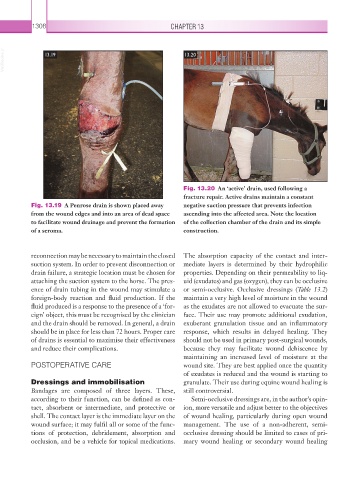Page 1333 - Equine Clinical Medicine, Surgery and Reproduction, 2nd Edition
P. 1333
1308 CHAPTER 13
VetBooks.ir 13.19 13.20
Fig. 13.20 An ‘active’ drain, used following a
fracture repair. Active drains maintain a constant
Fig. 13.19 A Penrose drain is shown placed away negative suction pressure that prevents infection
from the wound edges and into an area of dead space ascending into the affected area. Note the location
to facilitate wound drainage and prevent the formation of the collection chamber of the drain and its simple
of a seroma. construction.
reconnection may be necessary to maintain the closed The absorption capacity of the contact and inter-
suction system. In order to prevent disconnection or mediate layers is determined by their hydrophilic
drain failure, a strategic location must be chosen for properties. Depending on their permeability to liq-
attaching the suction system to the horse. The pres- uid (exudates) and gas (oxygen), they can be occlusive
ence of drain tubing in the wound may stimulate a or semi-occlusive. Occlusive dressings (Table 13.2)
foreign-body reaction and fluid production. If the maintain a very high level of moisture in the wound
fluid produced is a response to the presence of a ‘for- as the exudates are not allowed to evacuate the sur-
eign’ object, this must be recognised by the clinician face. Their use may promote additional exudation,
and the drain should be removed. In general, a drain exuberant granulation tissue and an inflammatory
should be in place for less than 72 hours. Proper care response, which results in delayed healing. They
of drains is essential to maximise their effectiveness should not be used in primary post-surgical wounds,
and reduce their complications. because they may facilitate wound dehiscence by
maintaining an increased level of moisture at the
POSTOPERATIVE CARE wound site. They are best applied once the quantity
of exudates is reduced and the wound is starting to
Dressings and immobilisation granulate. Their use during equine wound healing is
Bandages are composed of three layers. These, still controversial.
according to their function, can be defined as con- Semi-occlusive dressings are, in the author’s opin-
tact, absorbent or intermediate, and protective or ion, more versatile and adjust better to the objectives
shell. The contact layer is the immediate layer on the of wound healing, particularly during open wound
wound surface; it may fulfil all or some of the func- management. The use of a non-adherent, semi-
tions of protection, debridement, absorption and occlusive dressing should be limited to cases of pri-
occlusion, and be a vehicle for topical medications. mary wound healing or secondary wound healing

